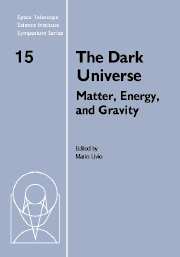Book contents
- Frontmatter
- Contents
- Participants
- Preface
- A brief history of dark matter
- Microlensing towards the Magellanic Clouds: Nature of the lenses and implications on dark matter
- Searching for the Galactic dark matter
- Hot gas in clusters of galaxies and ΩM
- Tracking the baryon density from the Big Bang to the present
- Modified Newtonian Dynamics and its implications
- Cosmological parameters and quintessence from radio galaxies
- The mass density of the Universe
- Growth of structure in the Universe
- Cosmological implications of the most distant supernova (known)
- Dynamical probes of the Halo Mass Function
- Detection of gravitational waves from inflation
- Cosmological constant problems and their solutions
- Dark matter and dark energy: A physicist's perspective
Hot gas in clusters of galaxies and ΩM
Published online by Cambridge University Press: 21 August 2009
- Frontmatter
- Contents
- Participants
- Preface
- A brief history of dark matter
- Microlensing towards the Magellanic Clouds: Nature of the lenses and implications on dark matter
- Searching for the Galactic dark matter
- Hot gas in clusters of galaxies and ΩM
- Tracking the baryon density from the Big Bang to the present
- Modified Newtonian Dynamics and its implications
- Cosmological parameters and quintessence from radio galaxies
- The mass density of the Universe
- Growth of structure in the Universe
- Cosmological implications of the most distant supernova (known)
- Dynamical probes of the Halo Mass Function
- Detection of gravitational waves from inflation
- Cosmological constant problems and their solutions
- Dark matter and dark energy: A physicist's perspective
Summary
X-ray clusters provide excellent constraints on cosmological parameters such as ΩM. I will describe measurements of cluster masses and of cluster evolution. The cluster baryon fraction and the evolution of the cluster temperature function strongly constrain the mean density of matter in the universe (ΩM). The constraints are consistent with ΩM = 0.2–0.5, with best fit values of ΩM = 0.3–0.4. The systematic uncertainties are of the same size as the statistical uncertainties, even with the small number of clusters in our current temperature surveys (ΔΩM ∼ 0.1.) Thus, reduction of the uncertainties in these methods requires not only an increased number of hot massive clusters in a given sample but much better quantification of the systematics, a goal which demands not only more clusters but clusters with a range of properties and redshifts. The current constraints are not particularly sensitive to the particular form or value of the acceleration parameter Λ and therefore these constraints provide an limit on cosmological parameters complementary to the limits imposed by the cosmic microwave background studies and by the Type Ia supernovae at cosmological distances.
Introduction
I seek to make the following three points in this review:
(a) Clusters of galaxies are excellent targets for cosmological studies.
(b) Existing studies have already placed very strong constraints on the mean density of matter in the universe.
(c) These constraints are nearly orthogonal to constraints from the cosmic microwave background and type Ia supernovae.
[…]
- Type
- Chapter
- Information
- The Dark UniverseMatter, Energy and Gravity, pp. 34 - 45Publisher: Cambridge University PressPrint publication year: 2004

